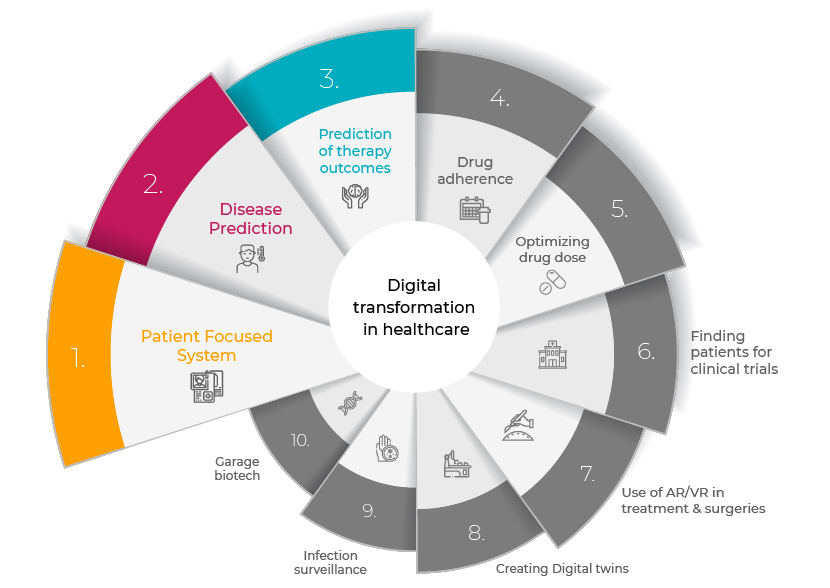Published on September 22, 2020 by Raghu Patale
Digital transformation in healthcare is the use of digital technologies to deliver health services – has come a long way from the time it started a few decades ago. Much of the coveted work has been in managing health records, but there has also been considerable progress made in drug discovery.
The adoption of digitalisation in healthcare has been slow given the complexity of the healthcare system and the involvement of human life. The lack of time on the part of and support from medical personnel have also contributed to domain-related challenges and slower adoption. Despite this, many new technologies are being developed, some even replacing older ones.

Listed below are notable trends/technologies that may become popular among patients and healthcare providers in the coming years.
Patient-centric systems
Zuzanna defines “patient centricity” as the process of designing a service or solution around the patient. Patient centricity has been one of the pressing needs of the healthcare system with a long and overwhelming journey for patients to go through, represented in the below image. While, both pharmaceutical companies and healthcare facilities are focusing on achieving patient centricity, yet, most of the newer solutions are hybrid in nature and solve only one piece of the puzzle; developing a truly patient-centric system is far from becoming a reality.
The delay in achieving patient centricity could also be due to the long-established system of viewing patient requirements through the lens of physicians, regulatory agencies and payers. Importantly, the healthcare system is undergoing change, where patients are actively involved in the processes or solutions are built to benefit them. We detail some of the progress below:
-
Babylon Chatbot is an autonomous AI tool that interacts with the patient and helps them to navigate the decision-making process. It partly addresses the issues of transparency and decision making in healthcare. It helps a patient describe their symptoms in the same way they would do to a doctor, poses a series of questions that a doctor would normally ask and helps them to choose the next steps.
-
Miaoshou is an integrated solution provider that helps patient with online consultation in combination with pharmacies and clinical services that would otherwise be at different locations or offered by different mobile applications. It offers convenience in terms of time and place and that too at a reduced cost.
Patient-centric systems will likely be more successful than traditional systems/offerings, as they focus on the end user. For instance, a recent survey conducted by Doctolib (one of the world’s top three online medical consultation providers) to analyse customer experience showed that 80% of patients and 74% of physicians would like remote consultation to continue, endorsing patient-centric models.
Pharma and health tech companies are also using digital technology to collate patient opinions to ensure that future products meet the needs of patients.
We believe, however, that the mindset of the different stakeholders of healthcare system needs to change to effect a wider adoption of such solutions.
Disease prediction
Diseases are currently diagnosed based on signs and symptoms. Benefits of the treatment provided, therefore, depend largely on the correct identification of the disease at the early stages, particularly in the case of infectious diseases and cancers.
This juggle between the timing of identification and effective treatment has effected a steady move from a diagnostic model to a prognostic one (predicting a disease long before the symptoms surface). These prognostic models are built by applying statistical models, deep machine algorithms or AI to multiple sources of health information (such as electronic history records, genomic data, wearable data, physical activity and food habits). There are a number of interesting dimensions along which research is progressing:
-
Google’s Verily has discovered a new way to evaluate an individual’s risk of cardiac disease using machine learning. By analysing scans of the back of a patient’s eye, the algorithm is able to accurately deduce, for example, the individual’s age, blood pressure and smoking habits, which can be then used to predict their risk of suffering from a major cardiac event.
-
The UCSF has created models to predict Alzheimer’s disease six years before a diagnosis, using a combination of glucose-based PET scans and deep machine learning. Such a prediction gives doctors enough time to prevent neurons from dying irreversibly.
These and similar tools would buy time for the patient and caregiver, making the healthcare system more efficient. They could also assist the healthcare system in terms of addressing the problem of a shortage of experts to correctly diagnose medical conditions.
Predicting outcomes of new therapies
The overall rate of failure in drug development is over 96%, with 90% of failures seen during clinical development. More than 80% of the investment and time is spent on establishing the safety/efficacy of new therapies in a new drug development cycle. To make this process lean and efficient, pharma companies are turning towards digitalisation to predict therapy outcomes using AI-/ML-based solutions to predict therapy outcomes.
AI/ML is applied at different stages of drug discovery, for instance, for predicting the behaviour of a drug inside a cell, selecting patient groups for clinical trials, or choosing models for running shorter trials. There is significant opportunity in this space: 230 startups were testing such processes as of 24 June 2020, albeit with low success rates and substantial gaps to bridge. Alongside these start-ups, pharmaceutical/ technology giants such as Bayer, Novartis, and IBM are also putting their domain expertise to the test.
We are also seeing positive results from these AI/ML based experiments. For example, the first non-man-made drug (DSP-1181) will be tested in phase one human trials in Japan. This was developed within a remarkably short span of 12 months by Japan’s Sumitomo Dainippon Pharma and Exscientia for treating OCD.
Therapy prediction tools and other tools used in drug discovery are likely to reduce drug development costs and benefit patients and economies.
Other interesting areas in which digital transformation is underway:
-
Promoting drug adherence
-
Optimising drug dose at an individual level
-
Finding patients for clinical trials
-
Identifying breakthrough events in a patient’s life
-
Using augmented/virtual reality in treatment and surgery
-
Creating digital twins in healthcare
-
Building garage biotech
Where does healthcare digitalisation go from here?
Digital transformation is taking us from remedial to preventive healthcare – a whole new healthcare ecosystem. The change will likely be facilitated primarily by sensors that can track the body from head to toe and by genetic testing tools. This data could then be fed into the software/machine-learning process to obtain insights on individual performance and predict when the individual (like an engine) needs maintenance/repair. We may, therefore, not need to undergo regular health check-ups except when indicated by these high-end sensors and algorithms, which would also notify the individual and their doctor of specific tests/procedures that need to be conducted as a preventive measure.
This also means that healthcare technology will be moving towards understanding each patient deeply, contrary to the current system that considers average metrics and the usual therapies. For instance, average body temperature is considered to be 37°C, but it could range from 33.2°C to 38.2°C. Similarly, current therapies are ineffective in 38-75% of cases depending on the type of disease. Digital transformation may also enable physicians to understand and overcome situations where current medications are ineffective.
About Acuity Knowledge Partners:
With a deep understanding of industry dynamics and nearly two decades of experience, Acuity Knowledge Partners is able to empower and assist healthcare clients to navigate these challenging times by strengthening their strategies and businesses.
For more information on our capabilities, please visit our Life science solutions page.
References:
https://social.eyeforpharma.com/patients/patient-centricity-what-it-and-why-arent-we-there-yet
https://www.nature.com/articles/s41598-019-54849-w#ref-CR1https://www.taconic.com/taconic-insights/quality/drug-development-process.html
https://www.digitalauthority.me/resources/artificial-intelligence-pharma/
https://www.youtube.com/watch?v=AJSxCCGsoR8
https://pubmed.ncbi.nlm.nih.gov/12000664/
https://www.gartner.com/en/documents/3191718/business-drivers-for-healthcare-provider-information-tecWhat's your view?
About the Author
Raghu Patale serves as Delivery Manager leading the Life Sciences Corporate Strategy Research and Consulting vertical. His responsibilities include thought leadership, setting up new client engagements, client management, and generating business insights. He has over 10 years of experience in conducting life science research as a competitive intelligence and strategy consultant. He has supported a wide spectrum of client engagements focusing on competitive intelligence, therapy area research, market opportunity assessments, M&A support and report writing in oncology and other therapy areas for US, EU5, and Asian geographies.
Prior to this, Raghu was a Group Manager, leading the Pharma Practice at Evalueserve. He holds a Master’s degree in Pharmaceutical..Show More
Like the way we think?
Next time we post something new, we'll send it to your inbox










